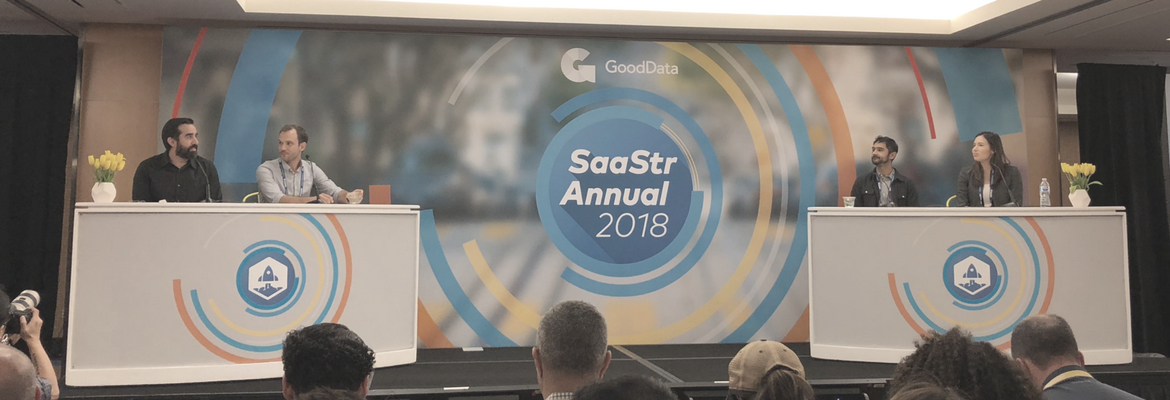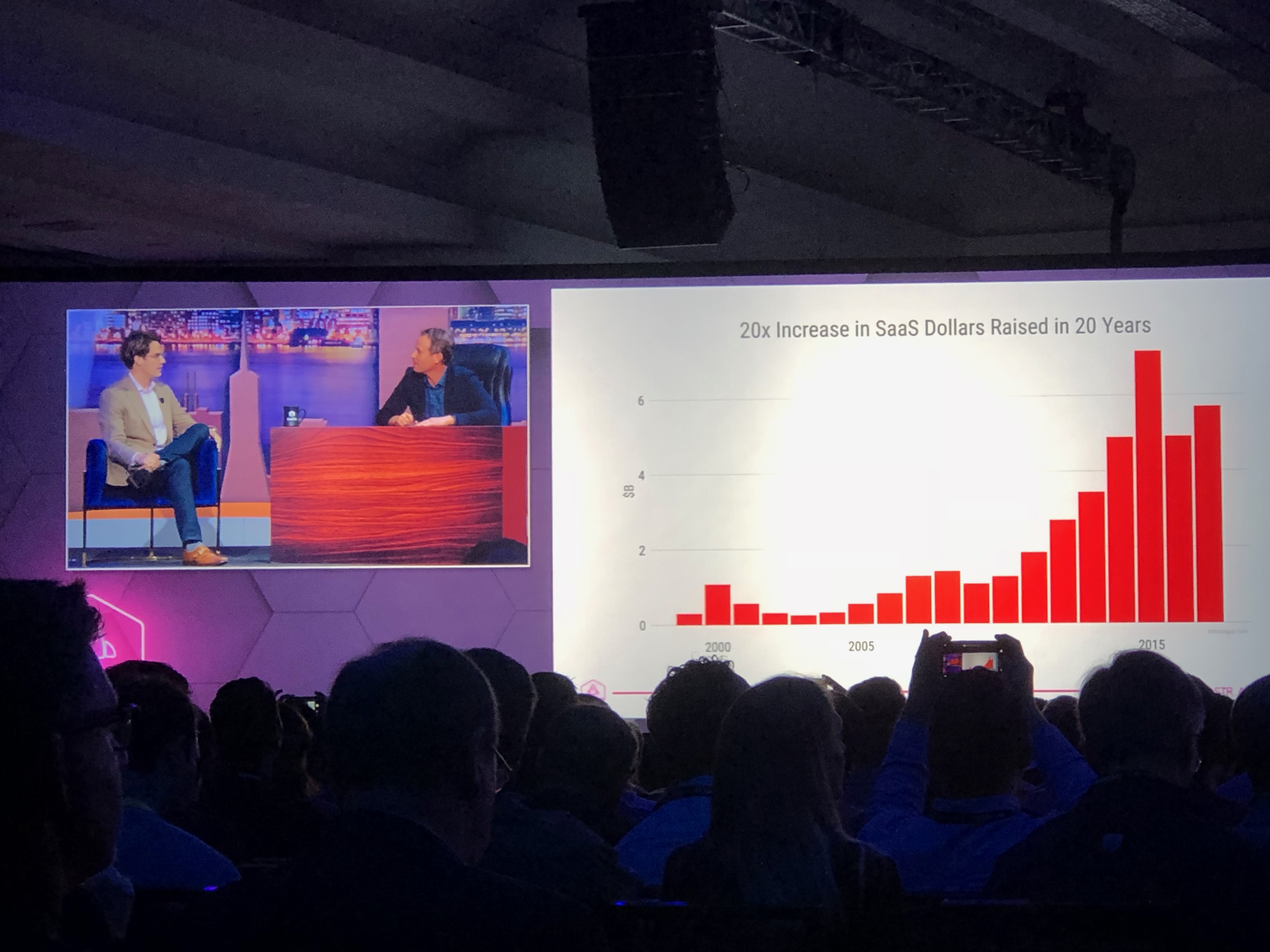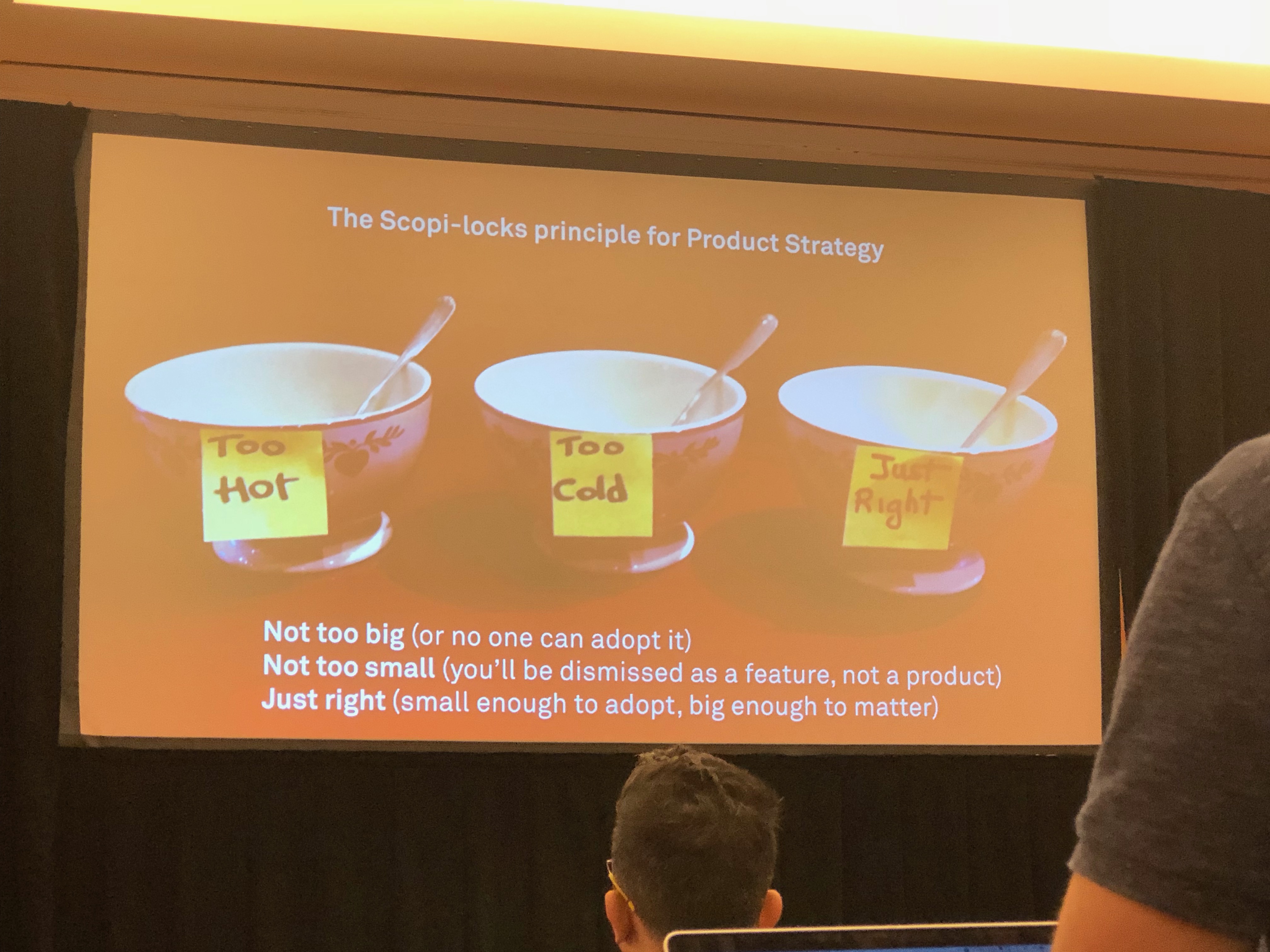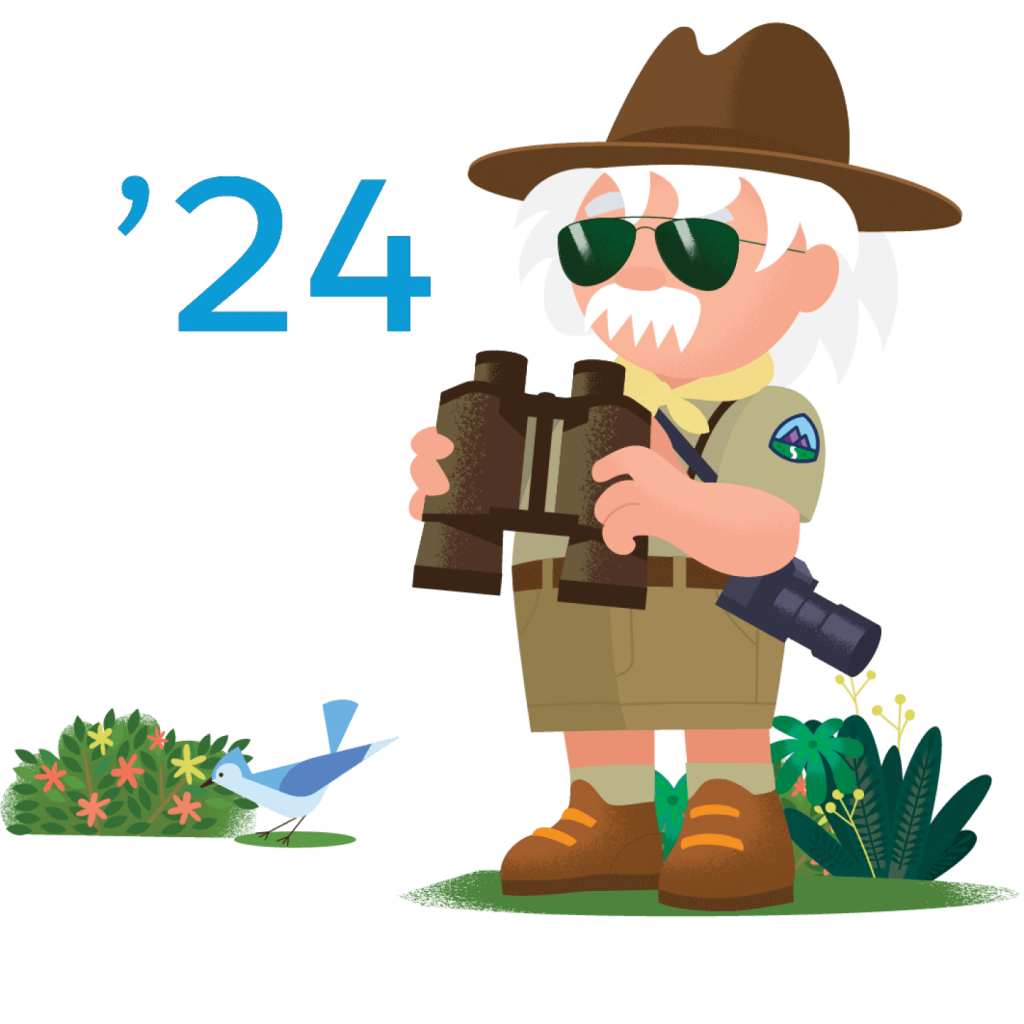
We showed up to SaaStr Annual with high expectations after last year, where we tried our best to process information overload into helpful information. That meant quotes, AppExchange-centric panel tips, advice for Salesforce ISVs, SaaS success stories, and closing six-figure deals.
This year’s presentations were everything we hoped for and then some. There are great day-by-day breakdowns already available (Day 1 | Day 2 | Day 3), so we decided to pull out perhaps the biggest theme across the show: SaaS growth (it’s happening now, and there’s more where that came from).
Here are our key takeaways processed from notes on many sessions, with quotes and advice for anyone who missed the conference, couldn’t be everywhere, or just needs a refresher. (With all of the insights and sound bites flying, some quotes may be paraphrased from our notes in good faith).
Are you at risk of not making it to market?
1. SaaS Opportunity Will Keep Expanding
Maybe the most revealing “State of” type lesson at the conference was that despite unprecedented SaaS growth in the past decade, it’s still all systems go for opportunity in the current climate — from lean startups in early stages to “decacorns.”
SaaS godfathers Tomasz Tunguz and Jason Lemkin discussed the State of SaaS in terms of funding opportunities and new growth terms. While in the past, many tech startups were classified as “unicorns” — valued at $1 billion — some startups are now being deemed “decacorns” — valued at $10 billion. (That’s a lot of horns).
“The reality is that cloud software penetration is still really low,” Tungaz says. “I think we’re probably in the 3rd or 4th inning.”
The amount of money raised for SaaS companies has increased 20 fold in the past 20 years, allowing companies the opportunity to receive funding in a variety of ways, including initial public offerings (IPOs), private equity (PE), and initial coin offerings (ICOs). (More than $4 billion was raised by ICOs in 2017, with the median amount raised being $15 million versus just $7 million from VC funding).

Much of the opportunity in the forecast comes from whole industries, and swaths of buyers, who have not switched to SaaS software. Lemkin and Tungaz expect the trend to penetrate these untapped industries, contributing to overall revenue growth.
At the company level, non-tech buyers are making 60+ percent of acquisitions — meaning established organizations are seeing huge revenue potential through both investing in and acquiring high-growth SaaS organizations that fill a market need.
2. Your Customers Drive Partnerships; Your Partnership Strategy Must Drive Revenue
Thought leaders from Slack, Stripe and Segment joined a panel on How to Build Out a Revenue-Generating Partnerships Strategy. The key insight — trust; build relationships with your customers and utilize them to drive buy-in and new business.
This (paraphrased) quote from Stripe’s Head of Business Development & Partnerships Cristina Cordova illustrates why customer demand drives partnerships across the SaaS ecosystem.
“Your customers want to work with you, your product and a whole ecosystem of related products,” Cordova said.
Customers drive partnerships. They want to work with you, your product, and a whole ecosystem of related products. @stripe #SaaStrAnnual pic.twitter.com/WRjoCZYifD
— codescience (@codescience) February 7, 2018
The best and most organic way for utilizing partnerships to build business includes channeling connections with companies at similar stages to yours and with mutual benefit (an example is that Stripe helped Shopify simplify onboarding, who then white-labeled Stripe for a better customer experience for both companies). For an example of a surprise home run, look at the integration between Slack and Google Drive. Slack Head of Platform Partnerships Jassim Latif said “it has changed people’s workflows” by reducing context switching, and “feels like it’s just a part of Slack.”
For high-growth organizations, the partnership emphasis is on revenue generation. How can you merge your connections with your business outcomes to drive revenue?
One of the best ways to do this is to know — truly know — your customers’ businesses.
“Your customers expect you to know them better” – @HeidiBullock on keeping marketing relevant post-sale to impact retention, cross-sell, upsell. #saastrannual
— InsightSquared (@insightsquared) February 7, 2018
That drives revenue through at least three different sales opportunities through a single strong relationship.
Phillip Fernandez, former CEO of Marketo, hit the theme of owning — and driving — revenue as the first of 10 lessons offered on what he would do differently this time around. He advises that companies hire someone with a sales background who’s responsible for all “revenue soup” even before sales and marketing roles. That hire will own the entirety of the lifecycle, building an integrated strategy that should incorporate your customer success piece.
3. Live the Life of Your Customers
In SaaS, building successful products must stem from an end-user perspective — what’s useful enough and valuable enough to capture the hearts and minds of your customers?
ServiceMax CEO Dave Yarnold dubbed this customer-centric approach to testing product “eating your own dog food,” while championing devotion to understanding the customer experience in great detail.
Not only did Yarnold hire employees who previously were in the same roles as his customers to mine them for insights, he instituted company-wide “ride alongs.” His employees were required to spend time with customers living their business lives, encouraged to ask questions, and then invited to share what they learned with the whole company.
With the subject of Yarnold’s speaking slot “Journey to the Billion Dollar Exit,” there’s obviously value in emulating this customer obsession. As Jason Green, Founder and General Partner of Emergence Capital said, “companies are not sold for $1 billion, they are acquired for $1 billion.”
4. Write Your Own Story
We were totally inspired by a session featuring Therese Tucker, CEO of BlackLine, sharing myths and misconceptions about building a startup. She overcame so much adversity on her journey!
Tucker highlighted some double standards in VC funding (shocking to see less than 2% of funding going to women-run companies). As an “old, female, single mom,” she channeled her experience with her career and family into an adaptive and problem-solving approach to business.
It is a hard truth that women are undervalued. “If you value someone in a market that is undervalued you will get a tremendous asset,” Tucker said. Keeping in mind the current tight labor market, it’s interesting to note that half of Blackline’s C-suite is women.
Tucker hit a fork in the road in 2007 when she had to decide on if BlackLine was going to be a SaaS or on-premise software company (and luckily, chose right).
The biggest myth she discussed was that you are founding the next Oracle, Salesforce, Amazon, or gigantic company; her truth is, you need to write your own story because you have no idea where you’re going and it’s a long road ahead.
“If there was a playbook that worked for everybody we’d all be making millions,” Tucker said. “There’s more than one way to get to top.”
We felt an immediate kinship with her ideas on injecting a little crazy into your company. When you are a startup and ramping up your team, she believes you have to pick two between good, cheap, and not-crazy. The clear choice is good and cheap (with a caveat that crazy means “fun / interesting” rather than psychotic). With the right talent development and culture, people will take a chance on you with a chance to grow. Our cowboy-shirt-wearing, Christmas-tale-weaving team is a little off kilter, but we wouldn’t have it any other way.
5. Things Break, Companies Plateau: Evolve!
Stitching together two thoughts from enterprise leaders on their journeys through scaling rapidly, it’s clear that the growth doesn’t happen in a straight line or exactly according to plan.
Marc Diouane, president of Zuora, cautions that there’s no smooth ride and success is not overnight, but that companies win through reevaluation and reinvention.
“At Zuora, in 5 years we had multiple plateaus to conquer,” says Diouane, with the first plateau stemming from the complexities of moving upmarket. “Every time you do something, think about how to push the envelope of the company. How can you evolve? Cross the plateau and gain another couple of years’ high growth.”
For Yvonne Wassenaar, a veteran of two fast-growth companies in New Relic and Airware, the biggest challenge was establishing process for retooling things that break as you go (because let’s be honest, most startups are cutting corners and taking shortcuts) — and standardizing the process so the problem doesn’t scale with the product.
“It’s the same in your organization – nothing is written down,” Wassenaar says. “That is great for 20 employees but not 400. You have to write decisions down, just like commenting the product code. ”
6. Consider the “Scopi-locks Principle” for Product Strategy
This sounds weird but stay with us — obviously there is much in common with a porridge-loving little girl and technology growth strategy. Much as Goldilocks sated her appetite with the bowl of soup that was “just right”, your product strategy must not be served too hot or too cold.

During a session called “Product Strategy at Scale,” Intercom CEO Des Traynor shared a number of principles of varying complexity. We found the simpler maxims and examples the most moving — including the mantra “build what you sell, sell what you build.”
Even awesome work that isn’t aligned with goals won’t help you build a company that hits the right notes. Imagine how many hard-won lessons (that you now can avoid) went into this slide:
Ugh how is there so much truth in one slide @destraynor @intercom #SaaStrAnnual pic.twitter.com/zUUfbLKcpk
— Jennifer Kim (@jenistyping) February 6, 2018
I raise my glass to all of my friends in product management with this quote from Traynor: “the road to shitty bloatware is paved with ‘just one more feature because the customer really needs it.’” The struggle is real.
By building products that are feasible, viable, and desirable, you’re focusing on initiatives that can be accomplished and are also effective, rather than solving rare problems or dealing with interminable build cycles that don’t accomplish much.
For anyone who attended, what did you derive from the conference? Feel free to send any notes, thoughts or insights to molly@codescience.com, and we might add your input to this post with credit and a company link.
Need help with taking advantage of this growth strategy? We help companies succeed on the Salesforce AppExchange, and are happy to explore channel opportunity if you contact us.



